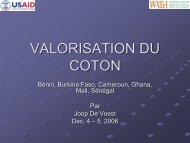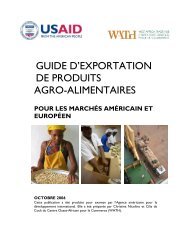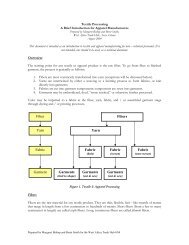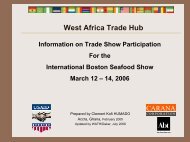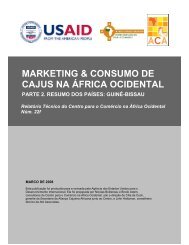Shea Butter A Guide to Production and Marketing - AGOA Export ...
Shea Butter A Guide to Production and Marketing - AGOA Export ...
Shea Butter A Guide to Production and Marketing - AGOA Export ...
Create successful ePaper yourself
Turn your PDF publications into a flip-book with our unique Google optimized e-Paper software.
Peace Corps Ghana Version 1, March 2008<br />
such as dryness, sunburn, burns, ulcers <strong>and</strong> dermatitis (Vuillet, 1911; Bonkoungou,<br />
1987) <strong>and</strong> <strong>to</strong> massage pregnant women <strong>and</strong> small children (March<strong>and</strong>, 1988).<br />
Having a high melting point of between (32-45°C) <strong>and</strong> being close <strong>to</strong> body<br />
temperature are attributes that make it particularly suitable as a base for ointments <strong>and</strong><br />
medicines (Bonkoungou, 1987). It is also used <strong>to</strong> treat horses internally <strong>and</strong> externally<br />
for girth galls <strong>and</strong> other sores. The healing properties of shea butter are believed <strong>to</strong> be<br />
partly attributable <strong>to</strong> the presence of allan<strong>to</strong>in, a substance known <strong>to</strong> stimulate the<br />
growth of healthy tissue in ulcerous wounds (Wallace-Bruce, 1995). It is used as<br />
“white oil” <strong>to</strong> anoint the dead in Niger (Castinal, 1945), <strong>and</strong> is placed in traditional<br />
ritual shrines.<br />
Refuse water from production of shea butter is used as a termite repellent (Dalziel,<br />
1937). In Burkina Faso, shea butter is used <strong>to</strong> protect against insect (Callosobruchus<br />
maculatus) damage <strong>to</strong> cowpeas (Vigna sp.). Research has shown that after treatment<br />
with shea butter a reduction occurs in the life span <strong>and</strong> fertility of the insects <strong>and</strong><br />
hence the infestation rate. <strong>Shea</strong> butter, however, is not as effective as cot<strong>to</strong>nseed or<br />
groundnut oil (Pereira, 1983; Owusu-Manu, 1991).<br />
Traditional Non-<strong>Butter</strong> Uses<br />
The shea tree is sacred <strong>to</strong> many ethnic groups <strong>and</strong> plays an important role in religious<br />
ceremonies (Vuillet, 1911; Millee, 1984).<br />
Flowers, Fruits, <strong>and</strong> Nuts<br />
Some ethnic groups make the flowers in<strong>to</strong> edible fritters (Chevalier, 1949). The fruit<br />
pulp, being a valuable food source, is also taken for its slightly laxative properties<br />
(Soladoye et al., 1989). Although not widespread, shea nut cake is used for cattle feed<br />
(Salunkhe <strong>and</strong> Desai, 1986), <strong>and</strong> also eaten raw by children (Faegri, 1966; Farinu,<br />
1986). The residual meal, as in the case with shea butter, is also used as a<br />
waterproofing agent <strong>to</strong> repair <strong>and</strong> mend cracks in the exterior walls of mud huts,<br />
windows, doors <strong>and</strong> traditional beehives. The sticky black residue, which remains<br />
after the clarification of the butter, is used for filling cracks in hut walls (Greenwood,<br />
1929; March<strong>and</strong>, 1988) <strong>and</strong> as a substitute for kerosene when lighting firewood<br />
(Wallance-Bruce, 1995). The husks reportedly make a good mulch <strong>and</strong> fertiliser<br />
(FAO, 1988b), <strong>and</strong> are also used as fuel on three s<strong>to</strong>ne fires.<br />
Foliage<br />
Leaves are used as medicine <strong>to</strong> treat s<strong>to</strong>machache in children (Millee, 1984). A<br />
decoction of young leaves is used as a vapor bath for headaches in Ghana. The leaves<br />
in water form a frothy opalescent liquid, with which the patient’s head is bathed. A<br />
leaf decoction is also used as an eye bath (Abbiw, 1990; Louppe, 1994). The leaves<br />
are a source of saponin, which lathers in water <strong>and</strong> can be used for washing (Abbiw,<br />
1990). When a woman goes in<strong>to</strong> labor, branches may be hung in the doorway of her<br />
hut <strong>to</strong> protect the newborn baby. Branches may also be used for covering the dead<br />
prior <strong>to</strong> their burial (Agbahungba & Depommier, 1989).<br />
Page 8 of 28



